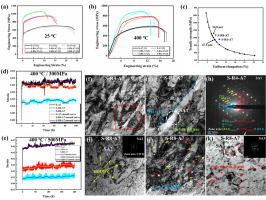Kink bands-mediated overcoming of strength-ductility trade-off and enhancement of creep resistance in a Fe-Cr-Al alloy
IF 14.3
1区 材料科学
Q1 MATERIALS SCIENCE, MULTIDISCIPLINARY
引用次数: 0
Abstract
In this work, kink bands (KBs) were introduced in Fe-Cr-Al alloys to simultaneously overcome strength-ductility trade-off and enhance creep resistance. KBs-containing samples exhibit exceptional mechanical synergy at room temperature, achieving a yield strength of 950 MPa, an ultimate tensile strength of 1.06 GPa, a uniform elongation of 9.5%, and a total elongation of 11.6%. Results indicate that this enhancement originates from complementary strengthening mechanisms of KBs-induced hetero-grain refinement and hetero-deformation-induced (HDI) hardening. Moreover, KBs-mediated crack deflection and grain boundary delamination effects preserve ductility. At elevated temperature (400°C), KBs maintain functional efficacy through persistent Hall-Petch strengthening and sustained HDI hardening despite significant grain boundary weakening. The suppression of boundary delamination arises fundamentally from reduced strain hardening differentials between grain clusters with high-density KBs and low-density KBs, mitigating intergranular crack initiation and propagation from interfacial strain incompatibility. Remarkably, KB-containing alloys exhibit superior creep resistance at 400°C and 500 MPa compared to their homogeneous counterparts. Creep deformation is primarily governed by screw dislocation glide, which results in a very low creep rate (4.3651 × 10−9 s−1) and negligible creep strain, outperforming other cladding materials.

扭结带介导的Fe-Cr-Al合金强度-延性权衡的克服和抗蠕变性能的增强
在本研究中,在Fe-Cr-Al合金中引入扭结带(KBs),以同时克服强度-延性权衡并提高抗蠕变性能。含ks的样品在室温下表现出优异的机械协同作用,屈服强度为950 MPa,极限抗拉强度为1.06 GPa,均匀伸长率为9.5%,总伸长率为11.6%。结果表明,这种强化是由kbs诱导的异质晶粒细化和异质变形诱导(HDI)硬化的互补强化机制引起的。此外,kb介导的裂纹偏转和晶界分层效应保持了延性。在高温下(400°C), KBs通过持续的Hall-Petch强化和持续的HDI硬化保持功能功效,尽管晶界明显减弱。对边界分层的抑制主要是由于高密度KBs和低密度KBs晶粒团簇之间的应变硬化差异减小,从而减轻了界面应变不相容引起的晶间裂纹的萌生和扩展。值得注意的是,含kb合金在400°C和500 MPa时的抗蠕变性能优于同类合金。蠕变变形主要由螺位错滑移控制,蠕变速率极低(4.3651 × 10−9 s−1),蠕变应变可忽略不计,优于其他包层材料。
本文章由计算机程序翻译,如有差异,请以英文原文为准。
求助全文
约1分钟内获得全文
求助全文
来源期刊

Journal of Materials Science & Technology
工程技术-材料科学:综合
CiteScore
20.00
自引率
11.00%
发文量
995
审稿时长
13 days
期刊介绍:
Journal of Materials Science & Technology strives to promote global collaboration in the field of materials science and technology. It primarily publishes original research papers, invited review articles, letters, research notes, and summaries of scientific achievements. The journal covers a wide range of materials science and technology topics, including metallic materials, inorganic nonmetallic materials, and composite materials.
 求助内容:
求助内容: 应助结果提醒方式:
应助结果提醒方式:


